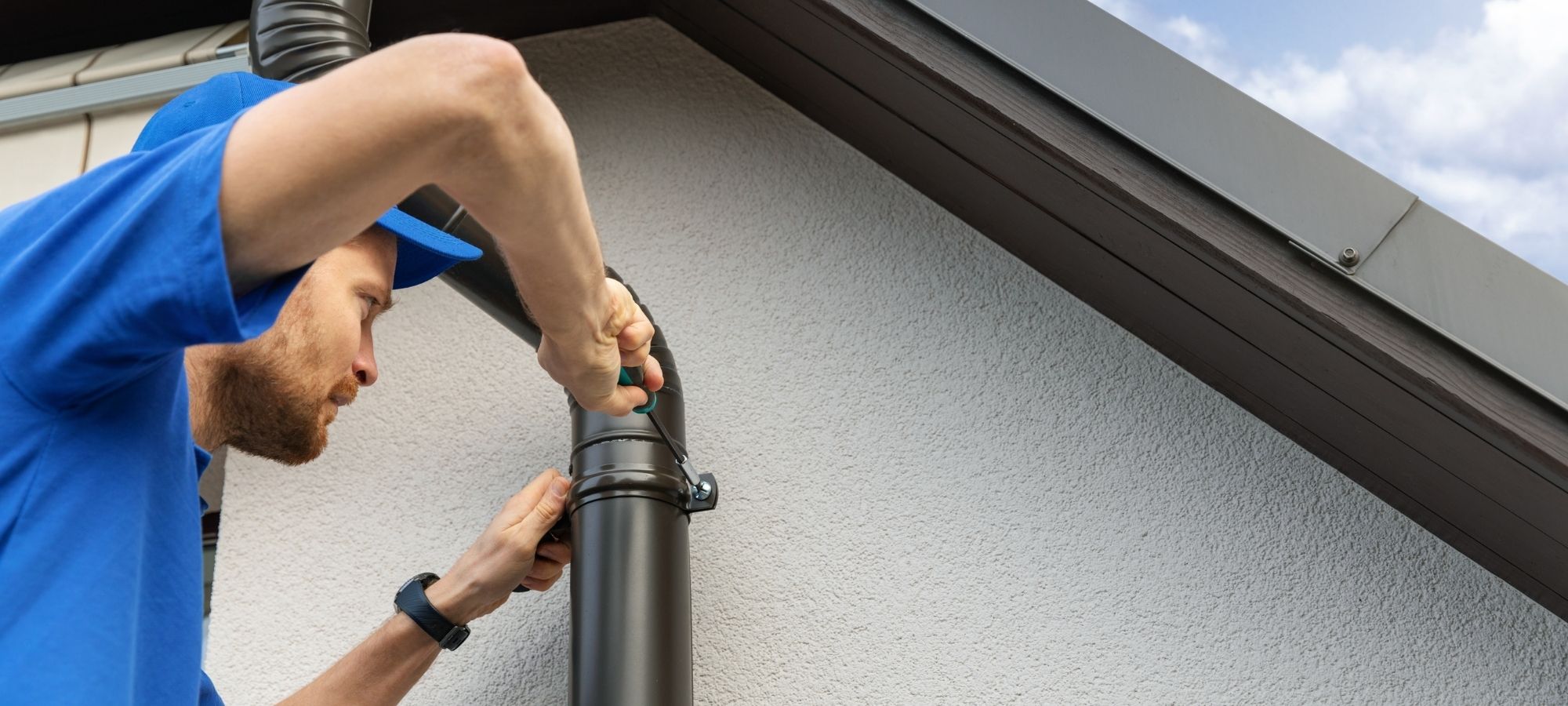How to Stop Overflowing Gutters

Overflowing Gutters
Gutters Overflowing is a common problem and it can damage your roofing. Depending on the causes of your overflow, it may be something that you can fix yourself or you may need to hire a professional to handle the issue.
One of the most common reasons gutters overflow is due to a clog. This happens when leaves, shingle granules, sticks from broken tree limbs or other debris finds its way into the gutter.
Water Damage to Roofing
Gutters are a key part of the roofing system. They act as trough-like fixtures that collect rainwater, then direct it away from the roof. This two-step process prevents leaks and moisture damage, which is why it’s important to keep your gutters in good condition.
The best way to keep your gutters in good condition is by regularly inspecting them and cleaning them. If you don’t do this, you may end up with a gutter that is so full of debris that it can’t effectively drain water.
When your gutters aren’t working properly, they can cause a variety of problems for your home. Some of the most common problems include leaking roofs, damaged foundations, flooded basements, and more.
While these issues can be costly to fix, you can avoid them by making sure that your gutters are clean and functioning correctly. Often, a simple inspection by a qualified professional can help you identify any issues that your gutters are experiencing.
Another problem that can lead to gutters overflowing is if the gutters aren’t pitched or fastened correctly. If this is the case, the water that flows over them can cause a lot of damage to your roofing.
Overflowing gutters can also be a sign of a more serious problem, such as ice dams. Ice dams occur when snow melts on the roof, but it can’t drain off the roof properly. The resulting ice can then block water from flowing and creating a clog in the gutters.
Clogged Gutters
If your gutters are clogged, it can lead to water damage on your siding and landscaping. It can also deteriorate your fascia boards and rot them.
When your gutters are clogged, it will also affect the way that the rainwater flows from your roof to your yard. If it’s too heavy for the gutters to handle, it will overflow and create a pool of water next to your home. This could eventually lead to a flooded basement or crawl space.
It is important to note that overflowing gutters can be a symptom of more serious problems, so it’s best to take action immediately. If left untreated, this water can seep into the walls and ceilings of your home, causing significant structural damage that requires expensive repairs.

Critters that are Attracted to Gutters
Gutters are often the perfect place for a variety of critters. They’re a great hiding spot, high up and away from predators. They’re also full of nesting material, twigs, leaves, and pine needles.
Besides nesting critters, gutters can be home to other types of pests as well. These pests can make a mess and cause damage to your property, so it’s important to keep them out of your gutters as much as possible.
The critters that are most likely to find their way into your gutters include ants, termites, mosquitoes, rodents, and snakes. It’s best to contact a pest removal professional for help if you suspect that any of these critters are inhabiting your gutters.
Ants love to nest near water sources, so it’s no surprise that they’ll look for a place in your gutter to build a nest. In fact, many ants will nest in your gutters without you even knowing it!
Rodents, especially mice, are also very attracted to a clogged gutter. They like to gnaw through wood, so if you see signs of rodent activity around your gutters, you might want to get them out of there as soon as possible.
Mice are very resourceful animals, so they’re often able to get around the perimeter of your house and into your attic. It’s not uncommon to find one or two of them hanging out in your gutters, but if they’re multiplying, it could mean serious trouble down the road.
Gnats are another pest that might make a home in your gutter. They prefer areas that are moist and full of decaying debris, so a clogged gutter will offer them the perfect opportunity to nest there.
Rats, too, are attracted to a clogged gutter as a place to hang out. They’ll climb into the downspout and make their way into your gutter system, where they can find shelter and food from the elements.
Raccoons and possums also enjoy a clogged gutter as a nesting spot. They are nocturnal creatures, so unless you’re staking out your gutters, you’ll probably never know they’re there. However, if you’re able to find them hanging out in your gutter, call animal control right away.

Debris in Gutters
Gutters are an essential part of a home’s drainage system. Without them, water can flow into the home, causing foundation damage and structural problems.
Debris is a common cause of gutter clogs. This debris can come from the trees around your property, as well as trash and plastic shopping bags. Other items that can accumulate in the gutters include shingle granules, metal pipes, and bird nests.
Leaves are another important item that can clog your gutters. This is because they can accumulate in the gutters and make it difficult for rainwater to flow freely through them.
If your gutters are overflowing, it may be time to clean them out. You can do this by using a ladder or a garden hose to remove the debris. However, you should always take safety precautions while cleaning out your gutters.
The minimum requirements for safe gutter cleaning include thick work gloves, a long-sleeve shirt and pants, safety glasses, nonslip footwear, and a sturdy ladder with smooth footing. This will help you keep your balance and avoid accidents when you are on the roof.
You should also check the gutters for unevenness and other issues before cleaning them out. This will help you determine whether the gutters need to be repaired or replaced.
Gutters that are too deep or narrow can also clog because they can hold more water than your downspouts can handle. This creates a backup that eventually spills over the sides of your roof.
One way to prevent a clogged gutter is to install gutter covers that encase the gutters. These covers are fabricated from vinyl or metal by a variety of manufacturers.
These covers feature a series of slots that are too small for leaves, twigs and sticks to enter the gutters. This allows water to flow over the gutter and into the downspout, but it does not allow debris to tumble into the gutter.
This makes it less likely for clogs to develop, but you should still inspect your gutters on a regular basis and clean them out if they become clogged.
How to Prevent Gutters from Overflowing
Gutters are a crucial part of your home’s roofing system. Without them, water could find its way into your home and cause serious damage to your roof.
Gutters also help keep rainwater from leaking into your basement. However, overflowing gutters can be a major problem that can be costly to repair.
Luckily, there are some simple steps you can take to prevent your gutters from overflowing. To start, you should thoroughly clean your gutters on a regular basis.
When your gutters are clogged with leaves, twigs, or other debris, water will not be able to flow through them smoothly. Instead, it will overflow the gutter and downspout.
This may result in pools of water gathering under the eaves or discolored siding on one side of your home. Alternatively, it can lead to mold and mildew in your walls and foundation.
If you notice these issues, you should immediately check your gutters for blockages. You should be able to spot them by the amount of water that overflows during a heavy storm.
While you’re at it, be sure to inspect your downspouts. These should be a distance away from your house, allowing for the rainwater to drain properly.
Another thing to look for is the slope of your gutters. They should be pitched properly so that water is able to flow easily off your roof.
You can measure this by using a level to determine how level your gutters are at the point where they meet your downspouts. A good rule of thumb is that they should be pitched at least 1/8 of an inch per 10 feet of gutter.
The bottom line is that if you keep your gutters cleaned and maintained, they should be able to handle most rainstorms. If not, you should consider hiring a professional to assess your gutters and possibly make necessary repairs.
Overflowing gutters are often caused by a combination of issues, including clogged gutters and poor drainage. While there are a few things you can do to address these problems, the most important step is to ensure that your gutters are working properly. If you’re not sure how to do this, consider hiring a professional who can perform a thorough inspection and provide a report on the status of your gutters.

